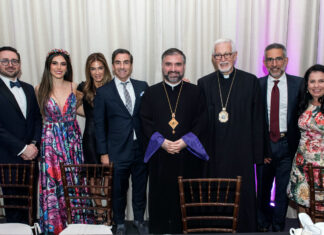By Aram Arkun
Mirror-Spectator Staff
RICHMOND, Va. — The Armenian community here held their 53rd annual food festival September 15 to 18 outside of St. James Armenian Church. Considering that there is only a small number of Armenians living in the area, the size of the festival is impressive.
The festival included Armenian folk music, provided by the Hye Keys. Perouz Manougian and Paul Mardigian are the two leaders of the seven-member band. Children from the St. James Armenian Dancers gave folk dance performances. Jewelry, crafts and arts, largely from Armenia, were displayed and sold at a booth, and information on Armenian history was posted on a tent wall. The main focus was food, of course. Cheese and spinach böregs, kebab, the famous “Hye burger” (a mixture of ground sirloin and lamb with spices), rice pilaf, string beans, hummus and stuffed grape leaves (dolma) were accompanied by Armenian coffee, Kotayk Armenian beer and Armenian red, white and pomegranate wines, along with soft drinks. Desserts included paklava, bourma, simit and kourabia cookies.
John Baronian, the senior member of the Planning Committee for the festival, moved to Richmond in the 1930s from Detroit as a young boy. He explained that 53 years ago, when the festival was started, it was held indoors as seated dinners: “Originally it was the Women’s Guild that started it in a small kitchen. I was involved as I was on the Parish Council of the church. The ladies ran it until I became chair. As the festival grew, we decided to have a food festival committee instead of just the Women’s Guild committee, but the ladies are still the backbone of it.”
The first three or four years, the festival only was intended for Armenians, but, Baronian explained, “when I got involved I had a small advertising agency and started advertising. This was in the 1960s. Our main purpose was to get Armenians better known in the Richmond community.”
Virginia native Chuck Ashjian handles the programming and advertising for the festival. He said that the festival expanded further to an outdoor format (in 2006) partly in order to meet the financial needs of the parish: “I was on the Parish Council for a number of years, and looking at our budget deficit, we needed to do something to improve the situation in order to keep a fulltime priest here. A few of us got together and came up with a plan and suggested that we take it outside since the Greek and Lebanese festivals were successful outdoors.”









